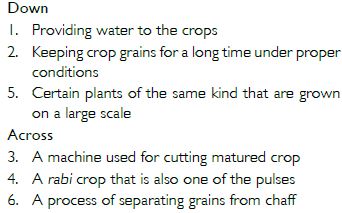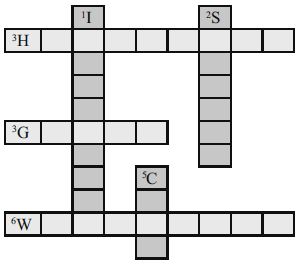Question 1:
The same kind of plants grown and cultivated on a large scale at a place is called __________
Answer:
Crop
Question 2:
The first step before growing crops is the __________ of soil.
Answer:
Preparation
Question 3:
Damaged seeds would __________ on top of water.
Answer:
Float
Question 4:
For growing of crops, sufficient sunlight and __________ and __________ from the soil are essential.
Answer:
Water, nutrients
Question 5:
Match items in column A with those in column B.
- Kharif crops
- Rabi crops
- Chemical fertilisers
- Organic manure
Answer:
(i). (a), (ii). (d), (iii). (b), (iv). (c)
Question 6:
Give two examples of each.
(a) Kharif crop (b) Rabi crop
Answer:
(a) Paddy and Maize, (b) Wheat and Gram
Question 7:
Write a paragraph in your own words
Preparation of soil
Answer:
Preparation of soil: Soil is loosened and overturned to make it better ventilated and suitable for the growth of tiny organisms living in it. The entire process is called ‘tillage and ploughing’. During dry season, ploughing turns the soil into big mud pieces or crumbs, which are then broken down with a plank. The ploughed soil is liable to be removed by wind and water. Therefore, a wooden leveller is used for pressing the soil.
Question 8:
Write a paragraph in your own words
Sowing
Answer:
Sowing: The process of planting seeds into the soil is called sowing. It is the most important part of crop production. Before sowing, good quality seeds must be selected. Seeds can be sown in fields by hand (broadcasting) or with the help of a seed drill.
Question 9:
Write a paragraph in your own words
Weeding
Answer:
Weeding: It is a process of the removal of unwanted plants, i.e., weeds from fields. It is necessary to remove weeds as they compete with the main crop for water, nutrients, sunlight, etc. Weeds may be removed manually by uprooting or cutting or by using chemicals called weedicides. Examples of weedicides are linazine, dalapon, etc. The best time to remove weeds is before they produce flowers and seeds. Hand removal of weeds can be done with a khurpi or a tractor-driven harrow.
Question 10:
Write a paragraph in your own words
Threshing
Answer:
Threshing: Separation of grains from the bulk of harvested plants is called threshing. Animals are used on a large scale for threshing. In large farms, a machine, combine harvester, is used for both harvesting and threshing.
Question 11:
Explain how fertilisers are different from manure.
Answer:
Question 12:
What is irrigation? Describe two methods of irrigation which conserve water.
Answer:
Applying water to the soil at regular intervals of time and in regular quantity is called irrigation. The time and frequency of irrigation varies from crop to crop, soil to soil and season to season. Latest irrigation methods that help in conserving water are:
a) Sprinkler system: This system is very useful on uneven land or on sandy soil. The pipes of the sprinkler system have rotating nozzles and are joined to the main pipeline at regular intervals. Water comes out from the rotating nozzles and is sprinkled on the crops as if it raining.
b) Drip system: In this system, water is added drop by drop to the soil just at the position of the roots. Water wastage is minimised and that is why drip system is a boon for regions where availability of water is limited.
Question 13:
If wheat is sown in the kharif season, what would happen? Discuss.
Answer:
Wheat is a rabi crop, i.e., it is grown in the winter season If it is sown in the kharif season, it will get more water, which is harmful to the crop. The wheat crop will neither be healthy nor will it provide a good yield.
Question 14:
Explain how soil gets affected by the continuous plantation of crops in a field.
Answer:
For better growth of crops, fertilisers are added regularly to a field. Fertilisers are nutrients like nitrogen, phosphorus, potassium, etc. Using them year after may change the nature of the soil. The soil may become too alkaline or acidic and less fertile.
Question 15:
What are weeds? How can we control them?
Answer:
Weeds are undesirable plants that grow naturally along with the crops. Removal of weeds is called weeding. Following methods can be used to control weeds:
a) Tilling: The process of loosening and turning of the soil is called tilling or ploughing. This is done by using a plough. Tilling uproots and kills weeds.
b) Manual removal: This method includes physical removal of weeds by uprooting or cutting them close to the ground. This is done with the help of a khurpi or harrow.
c) Chemical method: In this method, weeds are controlled or killed by using chemicals called weedicides. They are sprayed in fields with a sprayer.
Question 16:
Arrange the following boxes in the proper order to make a flow chart of sugarcane crop production.
Answer:
Question 17:
Complete the following word puzzle with the help of clues given below.






